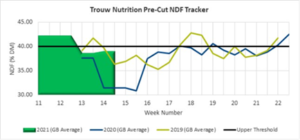Grass Growth
The warmer weather prior to the Bank Holiday weekend saw grass growth rates across GB follow a slow upward trend, exceed rates seen in 2020 and the 6-year average. However, with weather conditions turning colder again, current grass growth rates have fallen to 31.3kg DM/ha/day, much closer to the 6-year average of 30.1kg DM/ha/day. Grass growth rates are expected to increase rapidly through the rest of spring.
Milk Yield from Grazing (MYFG)
Potential Milk Yield from Grazing is currently higher than average, at M+6.8 litres. A result of potential DMI being 2.1kg/day greater than average and a slightly higher ME of 12.47, compared to 12.24 MJ/kg DM on average.
Higher MYFG versus previous years may also be attributed by a greater dynamic energy (DyNE) value of 6.94 MJ/kg DM vs 6.58 MJ/kg for the same period in 2019, revealing the true energy value of forage available for milk production.
Managing Butterfat at Turnout
Dairy cows are most at risk of low milk fat when grazing spring grass. Trends for the season so far have seen potential risk factors including high levels of acid load, Rumen Unsaturated Fatty Acid Load (RUFAL) and Rapidly Fermentable Carbohydrates (RFC). In addition, fibres index has declined this week from 169 to 161.
To reduce the risk of depressed butterfat following spring turnout, producers should aim to supply a diet that promotes a healthy rumen and high levels of fibre digestion:
- Offer straw or fibrous forages in buffer rations. This helps to promote rumination, saliva production and support optimal rumen conditions required for acetate-producing microbes
- Include stable live yeast cultures at recommended rates. This helps to remove oxygen from the rumen environment, improving conditions for fibre digesting bacteria and improving acetate production for butterfat yields
- Use of rumen buffers. This helps to maintain optimal rumen pH for acetate producing microflora
Pre-Cut NDF Tracker 2021
The NDF content of pre-cut samples submitted to the Trouw Nutrition GB lab for the latest period averaged 38.96%. This figure has been obtained from a relatively small sample size, thus individual sample submissions are encouraged to optimise first cut quality specific to farm and strength analysis.
Despite this latest data being within the optimised threshold of 38-40%, grass growth will have been impacted by the recent cold weather meaning grass quantity and quality may be compromised. As growth rates hopefully rise alongside favourable growing conditions, submission of samples to determine the pre-cut NDF content will be of great value to guide cutting decisions and optimise first cut quality and quantity.
Source: Trouw Nutrition.

